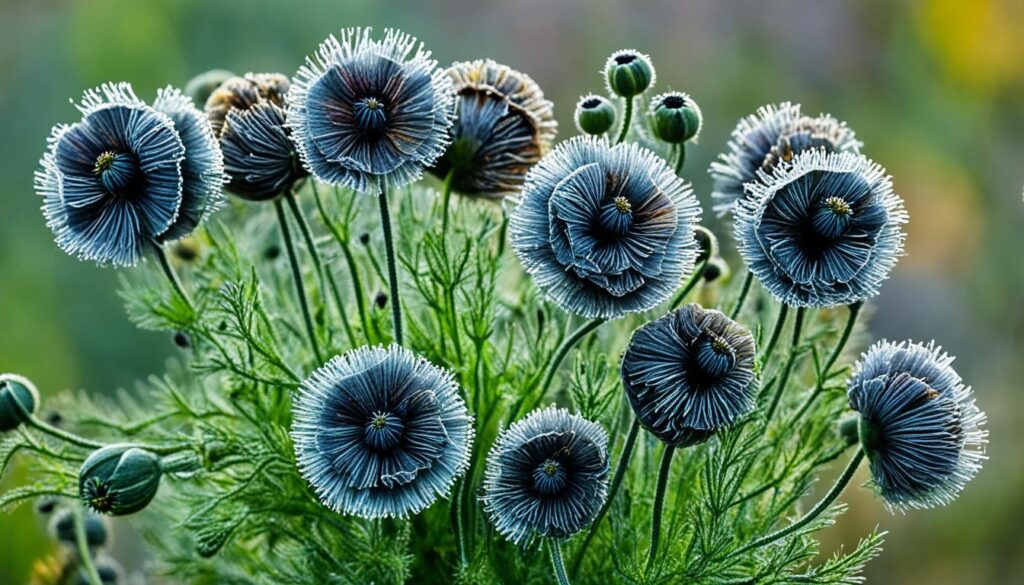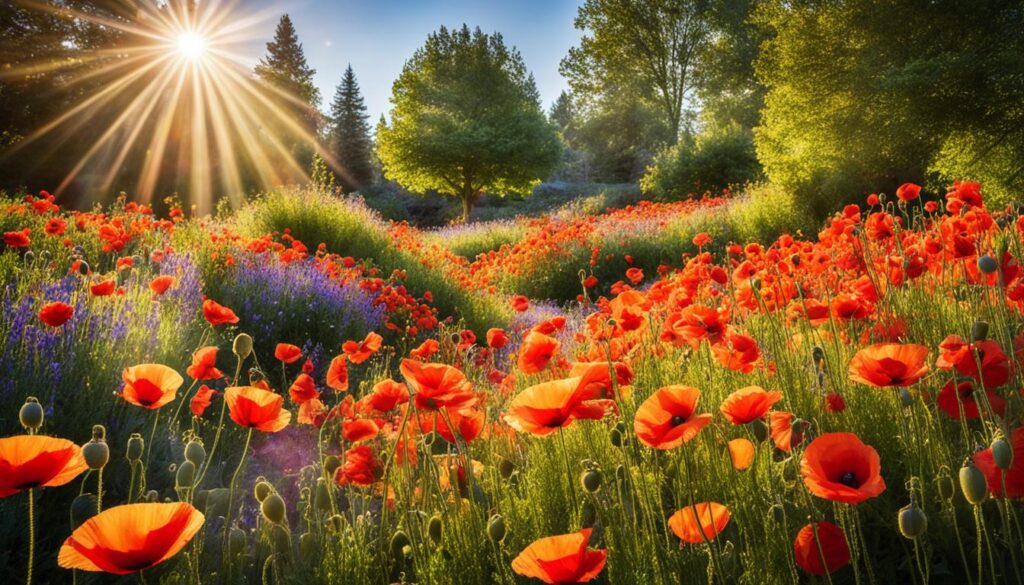Have you ever looked at the delicate, colorful poppies and felt enchanted? These flowers have a deep meaning and are loved by gardeners and bees. Ever wanted to know how to grow these poppy flowers in your garden? Learn all about poppy flowering secrets and how to grow them well.
Poppies come in four main types – Shirley, Breadseed, Oriental, and Iceland Poppies. Each type has its own look and way of growing. The red Shirley poppies and the fancy Breadseed poppies’ seed pods show the variety of these flowers.
Want to make your garden full of beautiful poppies? We will show you how in this guide. You’ll get to explore poppy growing, poppy field management, and their connection to some laws and the medicine world. This guide will teach you to grow poppies in a way that is good for the environment and shows their real beauty. Also, you’ll learn how poppies fit into the world around us.
Introduction to Poppy Flowering
Poppies are known for their stunning flowers that brighten gardens all over the globe. They have a deep history with cultures, faiths, and memorable events, which adds to their intrigue. Gardeners can choose from four main poppy varieties, each special in its own way.
The Allure of Poppies
Poppy flowering and poppy cultivation have fascinated people for ages. Their bold hues and fragile petals have inspired artists and writers for generations. The poppy holds a special place in many societies, from early religious traditions to its role in today’s arts and literature.
Varieties of Poppies
Shirley Poppies (Papaver rhoeas) boast iconic red flowers, while Breadseed Poppies (Papaver somniferum) stand out with their unique seed pods. Oriental Poppies (Papaver orientale) are loved for their vivid hues and eye-catching looks. Iceland Poppies (Papaver nudicaule) last long and make great cut flowers. Knowing about the different types is key for anyone looking to grow these beautiful plants.
Choosing the Right Poppy Seeds
Choosing the right poppy seeds is key to a successful garden. There are many types, from Shirley to Breadseed, Oriental, and Iceland Poppies. Each has unique needs and uses, so pick wisely for what you want.
Shirley Poppies (Papaver rhoeas)
Known also as Corn or Common Poppies, Shirley Poppies are simple to grow. They’re loved for their red blooms that look very traditional. These flowers have delicate, almost paper-like petals.
Breadseed Poppies (Papaver somniferum)
Breadseed Poppies have pods used in cooking or decorations. They don’t just come in white and pink, but also purple and blue. This diversity makes them unique among poppies.
Oriental Poppies (Papaver orientale)
Oriental Poppies, perennial plants, stand out with their bold colors and looks. With big blooms and solid stems, they’re striking in any garden. Their staying power makes them a great choice for years of beauty.
Iceland Poppies (Papaver nudicaule)
Iceland Poppies shine as cut flowers because they last a long time. Their thin petals and tall stems are perfect for arrangements. This makes them a top pick for those who love flowers indoors.

| Poppy Variety | Characteristics | Preferred Use |
|---|---|---|
| Shirley Poppies (Papaver rhoeas) | Easy-to-grow annuals with classic red blooms | Garden displays, cut flowers |
| Breadseed Poppies (Papaver somniferum) | Variety of colors, grown for seed pods | Culinary, dried arrangements |
| Oriental Poppies (Papaver orientale) | Vibrant colors, striking appearances, perennial | Garden displays, cut flowers |
| Iceland Poppies (Papaver nudicaule) | Delicate, paper-thin petals, longest vase life | Cut flowers, floral arrangements |
Planting and Growing Poppies
To grow big, colorful poppies, you need to know the right conditions and soil for them. Poppies love soil that drains well and is full of organic stuff. Adding compost or other rich soil builders before planting is key.
Preparing the Soil
Poppies do best in soil that’s not too acidic. Aim for a pH between 6.0 and 7.0. Mixing in compost or manure helps if your soil is heavy and doesn’t drain well. Make sure the soil is weed-free and not too compact before planting to help the seeds grow strong roots.
Direct Sowing vs. Transplanting
Direct sowing works best for poppies because they don’t like being moved. By sowing the seeds right where you want them to grow, you avoid damaging the tiny roots. This way, your poppies will start off healthier and showier.
Spacing and Thinning
Spacing is crucial when planting poppy seeds. They don’t mind being close, with about 10 cm between them ideal. After they sprout, thin them so the strongest ones have enough space. This process keeps your flowers from getting sick and looking their best.
Stick to these tips, and you’ll have a beautiful patch of poppies in your garden.

poppy flowering: Tips and Techniques
To grow beautiful poppies, you need to know a few things. Poppies love cool weather below 60 degrees Fahrenheit. In places with warmer climates, they can enjoy some shade to keep blooming.
When your poppies finish flowering, trim off the old blooms. This way, they’ll grow more flowers. It’s also good to leave a few seed heads. This lets them plant themselves for the next year. Knowing how poppies grow lets gardeners use these tricks. They can have a garden full of amazing poppies for a long time.

Deadheading and Self-Seeding
Proper maintenance of poppy plants includes poppy deadheading and poppy self-seeding. This is key for long-lasting blooms. Deadheading involves snipping off dead flowers. This process makes the plants produce more blooms. It helps the poppy flowering period last longer and stops seed heads from forming.
But, not all dead flowers should be cut. Letting some mature flowers drop seeds helps new poppy plants grow next season. It’s a way to keep your poppy patch alive.
Gardeners who use these methods enjoy beautiful poppy flowers every year. They strike a balance between cutting old blooms and letting seeds fall. This way, they have a gorgeous garden that keeps growing on its own.
Harvesting Poppy Blooms
Harvesting poppy blooms at the right moment is key. Pick them when the buds just start to open, showing their bright colors. This “cracked bud” stage means they’ll keep opening in the vase, giving a longer display.
Identifying the Right Stage
Watch your poppies closely to know when to pick them. The best time is when the petals are just starting to show color. Choosing them at the «cracked bud» stage ensures they will open fully in your vase.
Cutting and Post-Harvest Care
Cut the poppies deeply to help grow more flowers. After cutting, seal the ends by quickly heating them. This step is crucial for poppy harvesting to keep the poppy blooms fresh longer.
Poppies for Cut Flower Arrangements
Poppies aren’t usually top picks for cut flower arrangements. This is because they don’t last long when cut, known as their poppy vase life. Most poppies, except Iceland Poppies, last only 2-3 days in water. Still, their charm and many colors can’t be ignored. They are perfect for one-time events or short displays.
Getting the most days out of your poppies takes some work. You must treat the stem ends to keep moisture in. Also, store them in a chilly, dark spot until you’re ready to arrange them. If you choose the right kinds of poppies and look after them well, you’ll love how they brighten up your flower designs.
| Poppy Variety | Vase Life | Conditioning Tips |
|---|---|---|
| Shirley Poppies (Papaver rhoeas) | 2-3 days | Sear stem ends, keep cool and dry |
| Breadseed Poppies (Papaver somniferum) | 2-3 days | Sear stem ends, keep cool and dry |
| Oriental Poppies (Papaver orientale) | 2-3 days | Sear stem ends, keep cool and dry |
| Iceland Poppies (Papaver nudicaule) | 4-5 days | Sear stem ends, keep cool and hydrated |
Growing Poppies in Containers
Poppies are a great plant for poppy container gardening. The process of planting them in pots is similar to doing so in the ground. There are a few things to keep in mind. It’s important to pick a potting mix that drains well. Also, your container must have holes for water to escape. Poppies don’t like their roots to be too wet.
Plant the poppies about 10 cm apart. This lets them grow well and get enough air. Keep your eye on them for bugs and diseases, and water them regularly. With the right care, even mini gardens in pots can have beautiful poppy flowers.
| Container Size | Recommended Poppy Variety | Spacing |
|---|---|---|
| 12-inch pot | Shirley Poppies (Papaver rhoeas) | 10 cm apart |
| 16-inch pot | Breadseed Poppies (Papaver somniferum) | 10 cm apart |
| 18-inch pot | Iceland Poppies (Papaver nudicaule) | 10 cm apart |
Pollinators and Poppy Fields
Poppies add beauty and serve as crucial food for pollinators. Early morning sees a dance between poppies opening and insects visiting for nectar and pollen. This dance turns poppy fields into living paintings where the red blooms move with the breeze.
Gardeners become part of this cycle by letting some poppy seeds grow. This pollinator population benefits from a steady food source. It not only makes your garden prettier but also keeps the nearby poppy field ecology healthy.
Knowledge of how poppies and pollinators work together is key. By encouraging these links, gardeners can turn their space into a haven for poppy and wildlife. This enriches the garden with life and shows us the beauty of nature’s web.



